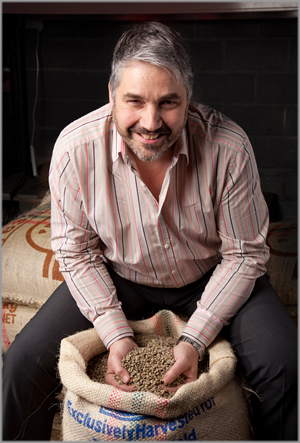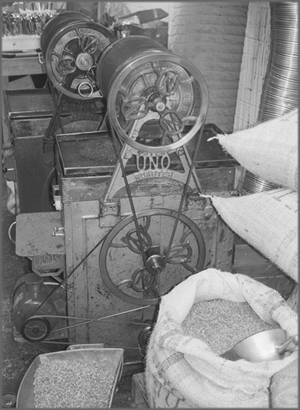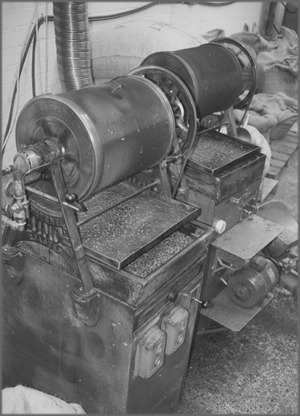

Roasting
At the heart of our coffee production is a magnificent 1968 Probat machine, nicknamed ‘Bertha’. Six reasons why the coffee we roast is great:
Bertha’s seasoned Drum : Being over 40 years old the chamber is wonderfully seasoned and produces glorious coffee under my watchful eye. A new roaster takes time to attain this, similar to the rules surrounding a wok but taking much longer.
 Water quench: This machine is completely different to many modern machines in that it doesn’t water quench the beans. This practice really isn’t good for the coffee as the hot beans will become steamed, dulling and altering the flavour. I have seen and used such a machine and have directly compared the two. Apart from the differences in character, the coffee simply smells so different when it is ground. Yes I am sure it helps the roaster's margin as it will reduce weight loss but it does nothing for the coffee. I will never water quench, water should only be used when you want to brew the coffee.
Water quench: This machine is completely different to many modern machines in that it doesn’t water quench the beans. This practice really isn’t good for the coffee as the hot beans will become steamed, dulling and altering the flavour. I have seen and used such a machine and have directly compared the two. Apart from the differences in character, the coffee simply smells so different when it is ground. Yes I am sure it helps the roaster's margin as it will reduce weight loss but it does nothing for the coffee. I will never water quench, water should only be used when you want to brew the coffee.
Aroma valve: One feature this machine has is what is referred to as an ‘aroma valve’. Put simply when the coffee is almost ready I turn the gas off and turn the valve closing the exhaust ventilation off. This means that the coffee continues to roast in its own heat and smoke, capturing some of the flavours that may have literally gone up the chimney!
Direct flame : There is a modern trend towards using indirect heat sources. This Probat doesn’t, enjoying direct flame which results in a full and developed roast. Many times I have cracked open the beans from other machines finding the coffee not evenly roasted and brown to the core. While that may be fine for your roast beef this is not good for great coffee and under-roasted coffee will taste undesirably grassy and thin.
Weight: One often hears of the term ‘built like a tank’ but this really is. Weighing in at over two tons this machine is from an era when industrial plant was made with heavy gauge metal and cast iron frames. These days, with the price of metal, corners are cut and economies are made. Pressed steel is used as the bean counters act to trim and lighten the design. On the face of it that is fine saving natural resources, however and critically the older heavier machine will have greater thermal retention and stability. All that metal soaks up and retains the temperature, so when a great load of raw coffee is dropped into the chamber the heat will transfer more stably into the beans, giving a better roast.
Roasting by origin: I roast every variety of coffee independently. Each coffee roasts differently, yes some very similarly but some are certainly not. By doing this one can tune the coffee to extract the best from each variety. This means a lot of hard work afterwards if one needs to create a blend as one then has to weigh off the beans to mix as an extra process which is why most coffee roasters don’t! The norm is to blend the raw coffee first, thus avoiding the extra work, however it’s not the same. A basic analogy I use is that you wouldn’t cook your peas and carrots together, it’s the same idea.

Me! Fifth generation in the industry I personally roast all the beans we supply with my trusty Probat roaster ‘Bertha’. She is gloriously manual and certainly not for the novice. We currently live in an age of digital and before then, analogue, but this is from the time when things were mechanical. No PCBs or digital readouts, you run her on intuition operating with six senses.
Sight - watching the coffee develop through the sight glass in the door of the roaster, watching the temperature while checking the time for profiling consistency. Taking a roasted bean and cracking it open to check that the coffee is fully roasted to the core.
Sound - listening to the coffee for as it becomes ready the coffee first cracks as the moisture leaves the beans under pressure from within. I have been called the coffee whisperer because of the attention I give listening to the coffee as it comes on song.
Smell - As the beans go through the various stages of the roasting process subtle changes occur in the fragrances that emanate from Bertha. The ability to recognise these changes helps me to pinpoint exactly where we are in the process.
Touch – As I use the machine operating the valves and levers at critical points throughout the roasting process.
Taste – obviously sampling the various coffees after roasting but also one can take a bean and chew it to gain an appreciation for the coffee just roasting. You receive quite a burst of flavour from a single bean although, repeating this a few times, the grains of coffee between your teeth isn’t the most attractive look!
Sixth sense is the hard part. Almost feeling the coffee and knowing when it is just right and sensing when it should be ready and dropping the beans into the cooling chamber at just the right moment. Reacting to the weather be it cold, hot, humid, dry or damp all these factors come into play requiring fine tuning adjustment, getting the coffee fettled just so.
Memoirs and experiences of coffee roasting
 I first learned to roast on a 7lb Wipmy roaster in what was known as Clifton Coffee Roasters when I was 18, a business bought by my father and traded under the Carwardines banner. A very exciting roaster as the beans literally passed through the flame taking the term’ flame roasted’ very literally. I remember roasting the Robusta variety was particularly hazardous as the ensuing sparks always set fire to the chaff bin so one always made sure it was empty before roasting this so there would be less to put out! I particularly remember the method of lighting it with a match which you would toss in and duck as it was fired back out at you as the gas ignited, still lit naturally so there was a scrabble to locate it. Certainly an exciting machine to use, which is why I acquired another when it became available recently, out of nostalgic interest.
I first learned to roast on a 7lb Wipmy roaster in what was known as Clifton Coffee Roasters when I was 18, a business bought by my father and traded under the Carwardines banner. A very exciting roaster as the beans literally passed through the flame taking the term’ flame roasted’ very literally. I remember roasting the Robusta variety was particularly hazardous as the ensuing sparks always set fire to the chaff bin so one always made sure it was empty before roasting this so there would be less to put out! I particularly remember the method of lighting it with a match which you would toss in and duck as it was fired back out at you as the gas ignited, still lit naturally so there was a scrabble to locate it. Certainly an exciting machine to use, which is why I acquired another when it became available recently, out of nostalgic interest.
After a spell abroad in the hospitality industry I went to learn about the wholesale business in the North West where Carwardines had a presence in Birkenhead. They used a 12Kg Probat machine which I remember as being an impressive device. I remember thinking it was so large and having a go so daunting. Lights, buttons, levers and controls all very exciting; little did I know that in the fullness of time I would be using a very similar machine only four times the size.
I then became involved with the wholesale side of the business, which was at that time a very small part of the business in comparison to the thirty odd coffee houses operating throughout the West Country. I assisted in a shop on a 1930s UNO barrel roaster in the window, which was a device which turned the coffee over the flames which were contained within in a mesh. This certainly reduced the Robusta fire hazard but introduced a new risk, the belt coming off. The whole machine was driven with leather belts which had a propensity to occasionally come off their guides. The drum then stops revolving, halting the beans over the flames which, containing a lot of oil, promptly would then catch fire, so a good level of attention was best. The other hazard was distraction, with customers popping in to pick up packets of coffee and tea, coupled to a phone which would invariably ring just at the moment your roaster critically needed attention I found it very easy to miss that moment, when the coffee is at its optimum, to drop the beans out at the correct time and level of roast. It was also hot as you had to work hard to open the door quickly taking much care not to touch any part as they were red hot. However the most memorable thing was blowing coffee smoke down the street which everyone thought was such a glorious smell. You rarely see this on the high street any more.
I also played with a small domestic Moda roaster which I tried to produce samples on but I learned a lesson at this point that all roasters are not the same as this dried the beans out too much rendering them very flat tasting.
The company then started producing a small 3lb roaster with the help of a local engineering company with a view to putting them into shops and delicatessens. The design was based on the Uno machine and its operation very similar. Having visited many of these and assisted clients with training, I found wildly differing results as operators battled with the manual nature of them.
 Progressively, my father then became involved with a company called Torftech and they jointly produced a device called a toroidal roaster. This spun the coffee around in a centrifugal manner on a bed of air. Fully automatic and very fast roasting process as the coffee would be ready in a matter of a couple of minutes. The applications seemed endless. But it was dogged with reliability issues and with the cessation of the family business I learned of it being scrapped by the new owners, which was a shame as there was a lot of shattered dreams there. Fully automatic, it had potential although I never cared much for the coffee it produced, already preferring the style of the older machines.
Progressively, my father then became involved with a company called Torftech and they jointly produced a device called a toroidal roaster. This spun the coffee around in a centrifugal manner on a bed of air. Fully automatic and very fast roasting process as the coffee would be ready in a matter of a couple of minutes. The applications seemed endless. But it was dogged with reliability issues and with the cessation of the family business I learned of it being scrapped by the new owners, which was a shame as there was a lot of shattered dreams there. Fully automatic, it had potential although I never cared much for the coffee it produced, already preferring the style of the older machines.
Intrepidly setting up on my own account, after the fall of the family enterprise, I started with a 7lb UNO coffee roaster from the 1930s, which I salvaged when a shop was being refitted in Weston-super-mare some years before. I just couldn’t face it being disposed of, but little did I know that this was going to become my first machine starting me off down a road of Artisan roasting. As hard and hot as ever, this became even harder when I acquired another twin machine to cope with demand, although a little younger having been manufactured in 1946! I remember having the good fortune to chat to the fellow who operated it after it was installed in Parsons down in Dorchester. Running two very manual open drum roasters is so very intensive as you are kept very busy tending both of them. The heat I remember, so you roll your sleeves up and then burn your forearms as you occasionally touch the hot cylinder; I still bear the scars and remember the smoke as you operate the machine immersed in the fumes.
During this time I remember picking up a pair of scales that I had agreed to buy locally through an advert in the then popular free ads paper Trade-It. After a hard day roasting on my two machines I drove directly to the seller's house. On meeting this stranger on his doorstep he quite suddenly asked me to wait and rushed off into his house leaving me a little bewildered. He calmly returned and I enquired what the matter was, he explained that he thought he smelt something burning - I then, rather embarrassed, had to explain that the source of the smell was actually myself! My clothes had become permeated with the smoke from the roaster from the day's activities.
After working very hard for the first few years of the business with my two roasters I sought a larger machine and embarked on a quest to find a new machine. I then learned of a large roaster becoming available in Northern Ireland and before I knew where I was a deal was struck and I was driving a van back to Bristol very slowly from the port of Stranraer, with a very heavy roaster as my cargo. It took many months of cleaning and restoring to put ‘Bertha’ as she is called back together. Amazingly parts are readily available from the factory which I am told is similar to Aston Martin, although I found out that you pay similarly!
That was almost twenty years ago and now she is still rolling along as good as the day I first set her up. Over time I have increased the cooling to help the beans cool faster improving the quality, increased the flame to assist getting that heat into the beans, but essentially she is just as she left the factory back in 1968 which just shows how if you build and engineer something properly just how well it can serve you.
Having used this roaster over such a long time I know exactly how to get the best from her delivering fresh flame roasted coffee not only locally, but now all over the country via our daily courier service.